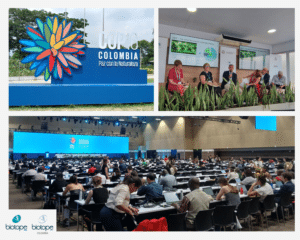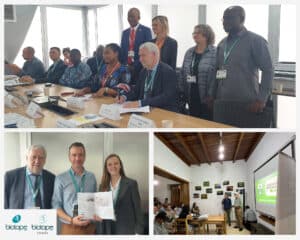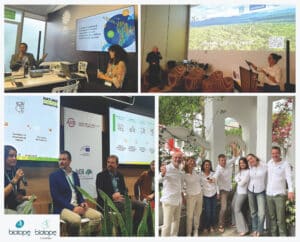Biotope : attending COP 16
From October 21 to November 1, 2024, in Cali – Colombia, our Biotope delegation had the honor of actively participating in the 16th Conference of the Parties to the Convention on Biological Diversity @COP16Colombia.
- Participations in several events in the Blue and Green zones
- Join us at our private venue “La Casa Biotope” for a series of hybrid conferences and in-person networking events.
We are very proud at Biotope to be among the major international players accredited for the Blue and Green Zones of COP 16 in Cali, in order to share knowledge and contribute to exchanges and debates.
Frederic Melki, Chairman, talks about the highlights to come.
“The protection of nature and biodiversity must be considered at different scales, and especially on an international scale. I hope that there will be major progress made, and that we will make connections that will allow us to pursue our ambition for a continued positive impact, and greater consideration for biodiversity throughout the world.“
Lien vers la vidéo : https://www.youtube.com/watch?v=INqj3f2OqS8
AN ENERGETIC FIRST WEEK
We’ve had a very exciting start at COP16 in Cali. There is a lot of energy in the blue zone with hundreds of events and people from all over the world, taking on the challenge of reversing biodiversity decline and the Global Biodiversity Framework commitments. In the green zone, there is a vibrant interest from civil society and many scientific and cultural conferences. We want to share a few significant events we either participated in or organized ourselves, with more to come until November 1st.

… ON BLUE ZONE
Biotope was invited to speak on October 22 during the session “Open Data for Biodiversity: Accelerating Monitoring and Action” held at the Multilateral Development Bank (MDB) Pavilion. The session focused on the importance of accessible, high-quality biodiversity data for achieving GBF goals, and discussed open data-sharing, suitable data systems, and expanded monitoring capacities. Biotope was praised for the quality of both its fieldwork and for leading the Data4Nature initiative sparked by AFD together with GBIF. We were grateful for the opportunity to participate in a great session and for the collaboration on OpenData strategies.
Biotope was invited on October 23 to the session “Strengthening NBSAPs Implementation Using Technological and Scientific Tools for Ecosystem Natural Capital Accounting”. This session demonstrated how new ecosystem accounting indicators and technological tools can strengthen NBSAPs as implementation instruments. The panelist shared best practices and lessons learned from developing, using, and implementing NBSAPs. They also discussed tools to develop more effective financial plans and conservation strategies aligned with the goals of the GBF. Environmental accounting (carbon, land-use and water) developed by Biotope for the Moroccan Ministry of Environment were presented during this event.
Biotope and Wildlife Conservation Society (WCS) hosted a side event called “Reconciling nature conservation and development: how to build an enabling environment and meet biodiversity targets”. The panel included Ann Nakafeero from the Government of Uganda, Stephanie Bouziges-Eschmann from FFEM, Marie-Cecile Thirion from AFD, Conrad Savy from The World Bank, Sean Narazerilli from Biofund, Ray Victurine from WCS and was moderated by Renald Boulnois from Biotope.
The panel discussed the objectives and achievements of the COMBO+ project, funded by FFEM, AFD and other donors, that is taking place in Guinea, Lao PDR, Madagascar, Mozambique and Uganda. The panelists shared how COMBO is achieving real success on the ground, through implementation of binding legislation, inclusion of all stakeholders and capacity building. The project is on the way to proving that mitigation hierarchy is a definite way to reconcile economic development and biodiversity conservation.
… AT LA CASA BIOTOPE
Sentinels of the Sea: How whales and dolphins are essential to the Global Biodiversity Framework
Ed Goodall, Whale & Dolphin Conservation (WDC) shared the global challenge for Cetaceans and the immense value they provide to many ecosystems. To learn more: https://uk.whales.org/
Julika Voss, BioConsultSH presented SPACEWHALE, an AI based tool to track and monitor whales. More information at: https://www.spacewhales.de/
Aurore Malapert, Biotope presented the project on the Conservation of Atlantic Humpback Dolphin in West Africa. More information at: https://www.sousateuszii.org/projects/research-capacity-building-and-conservation-for-atlantic-humpback-dolphins-in-guinea/
Improving the usability of primary biodiversity data: Innovative Tools and Actions from iNaturalist, Biotope, and GBIF
Carrie Seltzer from iNaturalist showed the power and usability of participatory data collection and sharing with iNaturalist.
Renald Boulnois from Biotope shared how the in-house app is used by staff and partners to ensure easy and accurate data collection and reporting in platforms such as GBIF.
Kyle Copas from GBIF, demonstrated the reach and value of the Global Biodiversity Information Facility (GBIF) platform.
Drones and Biodiversity: use-cases from coastal ecosystems in Germany, Colombia and the Arctic
Marc Schnurawa from BioConsult SH (Germany) provided background and context for using different types of drones, and also taking into account legal, technical and ethical considerations. Marc then shared a project where drones are used for evaluating beach litter in the Artic using AI.
Anna Kersten also from BioConsult SH talked usage of drones in the German “Wadden” sea to monitor coastal areas and to qualify and quantify habitats, birds and seals. Anna showed how drones coupled with AI allowed to improve data quantity and quality in a more efficient manner.
Diana Carolina Romero D’Achiardi from INVEMAR (Colombia) shared how her team is using drones for monitoring coastal and marine ecosystems in several parts of Colombia.
A BUSY AND INSTRUCTIVE SECOND WEEK OF COP 16
The Biotope team is grateful for the many opportunities we had to contribute to sessions on the Blue and Green zones. We met many long-time friends and partners, made new connections and were pleased with the success of our informative and networking events at La Casa Biotope in Cali.


… ON BLUE ZONE
On October 29th, Biotope was invited to speak during the session « Interoperable sustainable finance taxonomies: a key tool to mobilize private capital for the Global Biodiversity Framework implementation. »
Organized by the Working Group on Sustainable Finance Taxonomies for Latin America and the Caribbean (AC), this event discussed the role of sustainable finance taxonomies in engaging the private sector in biodiversity conservation. It highlighted the importance of interoperability across taxonomies to mobilize cross-border capital and present the LAC Taxonomy Common Framework for Biodiversity as an international best practice. This framework supports LAC countries in developing aligned taxonomies, enhancing comparability, and encouraging capital flows towards common biodiversity goals.
Biotope was instrumental in providing technical expertise for the working group.
October 30th, Committee of the International Coalition of Biodiversity Corridors in Africa.
The Steering Committee of the International Coalition of Biodiversity Corridors in Africa presented the Coalition’s progress and defined its roadmap for 2025 and beyond, coordinated by Climate Chance and under the patronage of ministries from France, Gabon, Guinea, Senegal and Tanzania. On this occasion, the French and Guinean governments signed a convention protocol on the protection of biological corridors in Guinea.
Biotope was recognized for its technical and scientific expertise to provide detailed mapping of the corridors. We are very happy to be part of this important initiative and project.
October 31st. Comparative Analysis of Biodiversity Measurement Tools for Public Development Banks
Nicolas Roques, Senior Biodiversity Expert at Biotope, presented a comparative study of six biodiversity metrics applied to nine EBRD and AFD investments. The analysis addressed PDB’s use context, with a Business Application and a more Organizational Focus Area, mentioning the tool scope and coverage, the sector-specific tool performance and their contribution to target 15 of the GBF. The panel then discussed varying results from different metrics and explored data requirements, staff skills, and accessibility challenges. The event also addressed reporting under the Taskforce on Nature-related Financial Disclosures’ guidelines, using concrete case studies.
Session participants:
- Henrick Linders (Head of Nature EBRD) for opening the session,
- Jean- Noël Roulleau (Biodiversity Expert, AFD) for presenting the Ecopronat Program
- Panelists: Nicolas Roques (Senior Biodiversity Consultant, Biotope), Gavin Edwards (Executive Director, Nature Positive Initiative), Julie Hammer-Monart (Policy Advisor, French delegation to COP16)
- Lamine Sow (AFD Country Director, Colombia) for closing the event
Special thanks to Maria Camila Porras, Biotope Colombia, for moderating the event.
… AT LA CASA BIOTOPE
Nat5 at COP16 – Biodiversity Credits: transforming projects in Nature Positive Assets, October 28th
La Casa Biotope in Cali hosted a presentation and networking event with Nat5. Nat5 aims to drive the global transition towards natural capital investment and ecosystem regeneration by :
- Certifying science-backed & nature-positive projects, and creating natural assets
- Establishing a link between project developers and buyers of credits & certificates
- Helping the installation of local and regional nature markets
The event was attended by over 30 project developers and investors interested in learning more about Nat5’s achievements to date, how Nature Positive Credits are certified, how they can be traded and contribute to the regeneration of ecosystems, biodiversity, water, and soil.
That same evening, within the Blue Zone of COP16, the International Advisory Panel on Biodiversity Credits (IAPB) launched its Framework for high integrity biodiversity credits, with support from the UK and France. The event promoted the IAPB Framework, discussed its implementation and its objectives for unlocking financial flows for nature conservation and restoration.
We were happy to see that Nat5 is aligned with the IAPB Framework of high-integrity biodiversity credits and will contribute to the overall GBF objectives.
Fondacion Palmarito, presentation and networking cocktail, October 30th
Alejandro Olaya Velásquez, director of the Palmarito Casanare Foundation, an organization dedicated to the defense, conservation, research, promotion and sustainable use of Colombian nature in general, with special emphasis on the Eastern Plains region and the Palmarito Casanare Nature Reserve, presented the Orinoco crocodile conservation program.
The caiman of the plains is a true crocodile that lives in the region of the Orinoco plains, shared by Colombia and Venezuela, one of the 12 most endangered species in the world.
For this reason, the Palmarito Foundation joined the National Program for the Conservation of the Plains Caiman in 2011. This program has been running since 1998 and involves institutions such as the Ministry of Environment and Sustainable Development, National Natural Parks, the Humboldt Institute, the National University, Corporinoquia, Cormacarena and the Governorate of Casanare.
In order to promote the captive breeding of the species with a view to the reintroduction of individuals into the wild, a series of improvements have been made in the Wisirare park (Orocué, Casanare) with the invaluable support of the GHL group, including an incubator for the development of embryos and enclosures for the rearing of hatchlings.
The presentation of this project was followed by the presentation of magnificent photographs of the plains taken by the famous photographer Dr Andrés Hurtado García. Journalist, ecologist and photographer from Colombia.
Fonds de Dotation Biotope pour la Nature : project “Life on Trees”
Maurice Leponce, scientific coordinator of Royal Belgian Institute of Natural Sciences (RBINS), presented the ‘Life on Trees’ (LOT) program at Casa Humboldt.
“Life on Trees” (LOT) program is a joint initiative of the Royal Belgian Institute of Natural Sciences (RBINS) and the Fonds de Dotation Biotope pour la Nature (FDD Biotope) in partnership with Instituto de Investigación de Recursos Biológicos Alexander von Humboldt.
The main aims of the research program « Life on Trees » (LOT) are to generate baseline knowledge about the number of species a single tropical tree can support and to understand how these communities of organisms are assembled. All eukaryotic life forms are studied: animals, plants, fungi and protists.
This is an unprecedented sampling effort in the canopies of three big trees and in restricted areas located at three altitudes (400, 800, 2400m a.s.l.) conducted over four years along the eastern side of the Andes:
- Amazon 2021-2022: located in Parque Nacional del Río Abiseo, Peru, at 400m a.s.l.,
- Andes 2023-2024: located in Parque Nacional Yanachaga-Chemillén, Peru, at 2 500m a.s.l,
- Amazon-Andes 2024-2025: located in a transition zone between the Andes and the Amazon, at the Natural Reserve La Isla Escondida, Colombia, at 800 m a.s.l.
The program also aims to support forest conservation and public outreach by demonstrating the importance of conserving large old trees in little disturbed habitats.
Thanks to Maurice Leponce, we have been able to realize the colossal amount of work involved in collecting data on a single living being under in situ conditions. This research will show the diversity of the living world that resides there
For more information: https://youtu.be/Z6x6ox3iANE?si=ekp0dnp-AuM176GU
IF YOU MISSED IT… : THE FULL PROGRAM
We reveal you the BLUE ZONE program : Blue Zone program
Discover the GREEN ZONE program : Green Zone Program
LA CASA BIOTOPE program : Program La Casa Biotope
It’s time to reveal LA CASA BIOTOPE program !
Four themed conferences that you can attend on site near Green Zone of COP 16, or simultaneous webinar on Teams :
- Sentinels of the Sea : How whales and dolphins are essential to the Global Biodiversity Framework ?
- Improving the usability of primary biodiversity data : Innovative Tools and Actions from iNaturalist, Biotope and GBIF
- ESG investing in real life : panel discussion around meeting challenges and taking concrete steps to protect biodiversity
- Drones and Biodiversity : use-cases from coastal ecosystems in Germany, Colombia and the Arctic